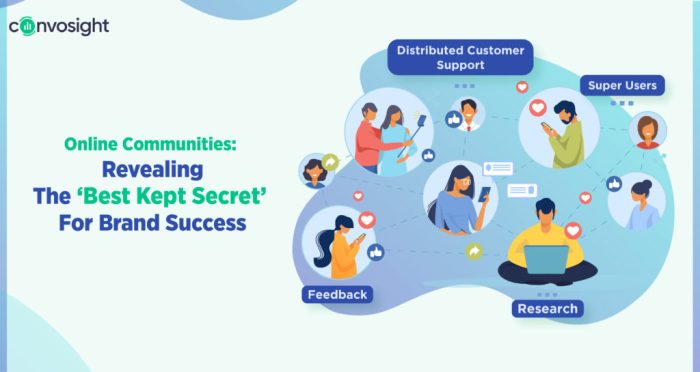Building an Online Brand Community takes center stage, inviting you into a world of digital connections that shape brands and engage audiences. Get ready to dive into the realm of online communities where relationships and loyalty reign supreme.
In this guide, we’ll explore the ins and outs of creating a thriving online brand community, from defining its essence to measuring its success. Let’s embark on this journey together!
Understanding Online Brand Communities

An online brand community is a group of individuals who share a common interest in a particular brand or product and engage with each other online through various platforms such as social media, forums, or dedicated websites.
Building a strong online brand community is crucial for businesses as it allows them to connect directly with their customers, build loyalty, gather feedback, and create a sense of belonging among consumers. This can lead to increased brand advocacy, higher customer retention rates, and ultimately, more sales.
Examples of Successful Online Brand Communities
- Apple’s online community, where customers can share tips, ask questions, and connect with other Apple enthusiasts. This has created a loyal fan base and valuable feedback for the brand.
- Lululemon’s “Sweat Collective” program, which offers perks to loyal customers who engage with the brand online and in-store. This has helped build a strong sense of community among fitness enthusiasts.
Differences from Traditional Marketing Strategies
- Online brand communities focus on building relationships and fostering engagement with customers, rather than just promoting products or services.
- Traditional marketing strategies often involve one-way communication from the brand to the customer, while online brand communities allow for two-way communication and interaction.
- Online brand communities rely on user-generated content and peer recommendations, which can be more authentic and trustworthy than traditional advertising.
Benefits of Building an Online Brand Community
Creating an online brand community for businesses can have numerous benefits that positively impact the brand’s growth and customer engagement.
Enhancing Customer Loyalty
Building an online brand community fosters a sense of belonging and connection among customers. By engaging with like-minded individuals who share a passion for the brand, customers are more likely to develop strong emotional ties to the brand, leading to increased loyalty and repeat purchases.
- Brand communities provide a platform for customers to interact with each other and the brand, creating a personalized and engaging experience.
- Customers feel valued and heard when their opinions and feedback are taken into consideration, strengthening their loyalty to the brand.
- Members of brand communities often act as brand advocates, spreading positive word-of-mouth and influencing others to try the brand.
Driving User-Generated Content and Word-of-Mouth Marketing
Online brand communities empower customers to create and share user-generated content, such as reviews, testimonials, and social media posts, showcasing their experiences with the brand. This authentic content resonates with other potential customers, driving word-of-mouth marketing and increasing brand awareness.
- Customers trust recommendations from their peers in the community, leading to higher conversion rates and a stronger brand reputation.
- User-generated content serves as valuable social proof, reassuring potential customers of the brand’s credibility and quality.
- By encouraging and rewarding customers for sharing their experiences, brands can leverage the power of word-of-mouth marketing to reach a wider audience organically.
Role of Online Brand Communities in Market Research and Product Development, Building an Online Brand Community
Brand communities serve as a valuable source of feedback and insights for businesses looking to improve their products or services. By actively engaging with customers in the community, brands can gather real-time feedback, test new ideas, and co-create products that meet the needs and preferences of their target audience.
- Customers provide valuable insights, suggestions, and critiques that can inform product development and innovation, leading to products that better resonate with the market.
- Market research conducted within brand communities is cost-effective and efficient, allowing brands to gather data and feedback from a targeted audience quickly.
- Engaging customers in the product development process fosters a sense of ownership and loyalty, as customers feel valued and involved in shaping the brand’s offerings.
Strategies for Building an Online Brand Community

Building an online brand community requires strategic planning and consistent effort to engage and retain members. Here are some key strategies to consider:
Initiating and Growing an Online Brand Community
- Start by defining your community’s purpose and goals to attract like-minded individuals.
- Create a user-friendly platform where members can easily connect and interact with each other.
- Promote your community through various channels, such as social media, email newsletters, and partnerships.
- Encourage active participation by organizing events, discussions, and contests to keep members engaged.
Importance of Engaging and Fostering Relationships
- Regularly interact with community members by responding to comments, messages, and feedback to show that their voices are heard.
- Build trust and loyalty by providing valuable and relevant content that addresses the needs and interests of your audience.
- Create a sense of belonging and inclusivity by celebrating member achievements and milestones within the community.
Tips for Creating Valuable Content
- Understand your audience’s preferences and tailor your content to meet their expectations.
- Deliver a mix of informative, entertaining, and inspirational content to keep members engaged and coming back for more.
- Use visual elements like images, videos, and infographics to make your content more appealing and shareable.
Leveraging Social Media and Other Platforms
- Utilize social media platforms to promote your community and engage with a wider audience through hashtags, live streams, and collaborations.
- Partner with influencers and brand ambassadors to expand your reach and credibility within your target market.
- Explore other platforms like forums, online groups, and webinars to diversify your community’s presence and attract new members.
Measuring Success of an Online Brand Community: Building An Online Brand Community
To determine the success of an online brand community, it is essential to track key metrics that can provide insights into engagement, growth, and sentiment within the community. By analyzing these metrics, businesses can evaluate the effectiveness of their community-building efforts and measure the return on investment.
Key Metrics to Track
- Membership Growth: Monitor the number of new members joining the community over time to gauge its popularity and reach.
- Engagement Rate: Measure the level of interaction and participation within the community, such as likes, comments, and shares on posts.
- Retention Rate: Track how many members continue to actively participate in the community, indicating loyalty and satisfaction.
- Sentiment Analysis: Evaluate the overall sentiment of discussions and feedback within the community to understand member satisfaction and brand perception.
Analyzing Engagement, Growth, and Sentiment
- Engagement: Use tools like social media analytics, community platform insights, and surveys to analyze member interactions and engagement levels.
- Growth: Monitor membership numbers, user activity, and referral sources to identify trends and opportunities for growth.
- Sentiment: Conduct sentiment analysis using sentiment tracking tools, monitoring, and sentiment surveys to assess member attitudes and feelings towards the brand.
Monitoring and Evaluation Techniques
- Use Google Analytics, social media analytics tools, and community platform metrics to track key performance indicators and measure community success.
- Implement surveys, polls, and feedback forms to gather insights directly from community members and evaluate their satisfaction and engagement.
- Utilize sentiment analysis tools and sentiment tracking software to analyze and interpret member sentiments and feedback effectively.
Examples of Measuring ROI
- A fashion brand measures ROI by tracking online sales attributed to community referrals and engagement, linking revenue directly to community efforts.
- A tech company assesses ROI by monitoring customer retention rates, customer lifetime value, and brand advocacy generated through the online brand community.
- A beauty company measures ROI by analyzing social media mentions, customer feedback, and brand sentiment to evaluate the impact of the community on brand perception and loyalty.





